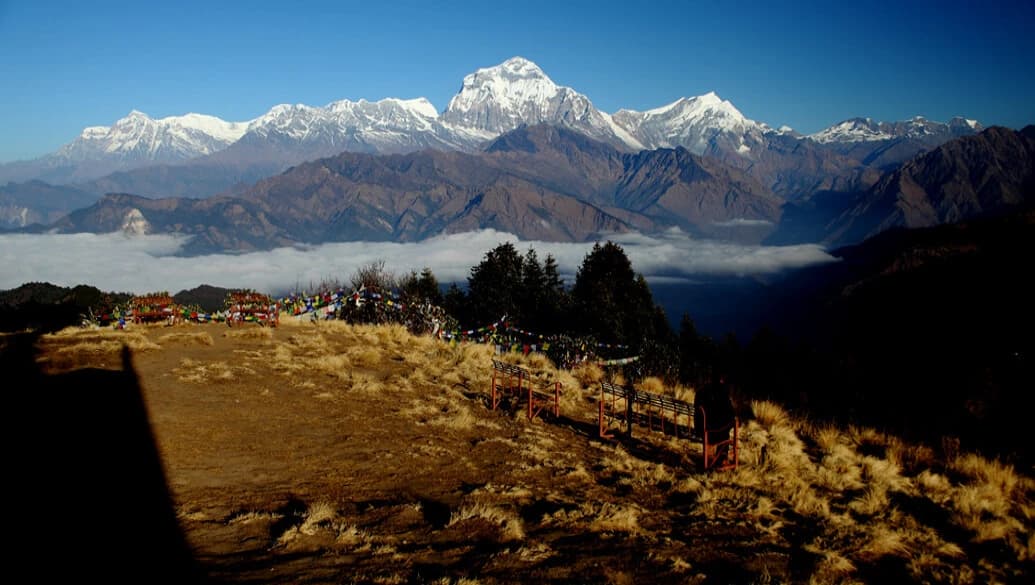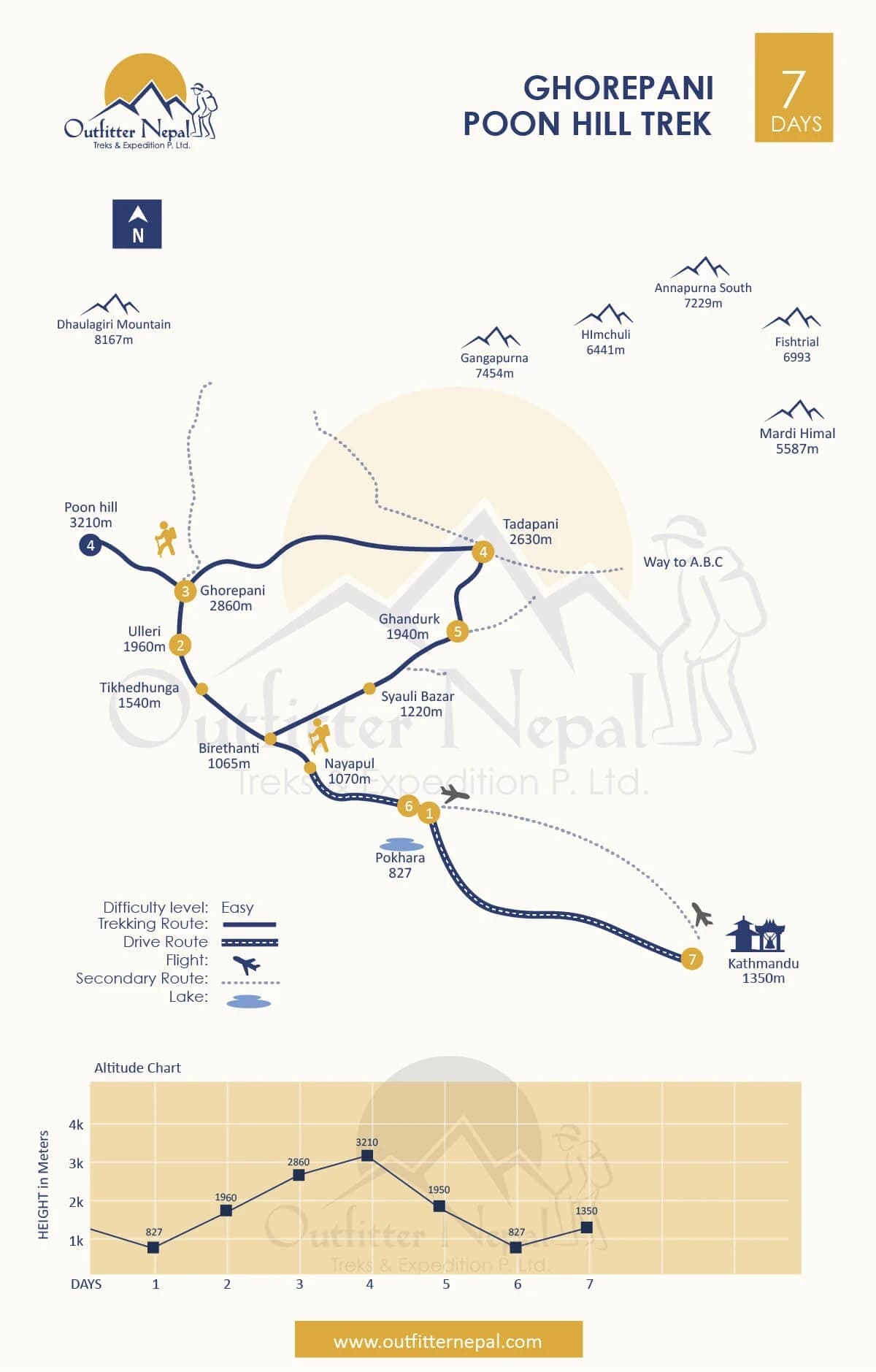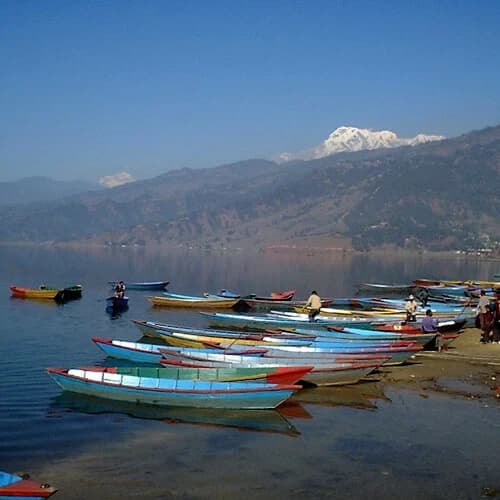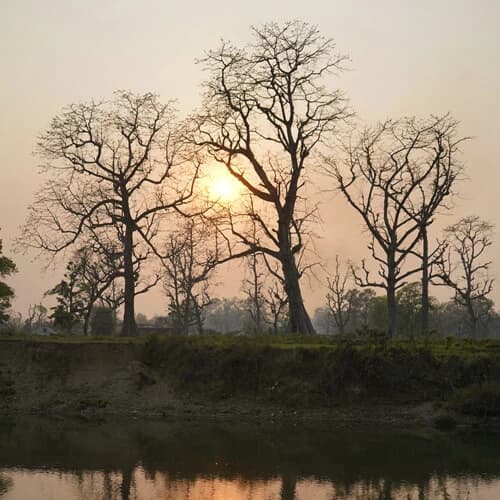Ghorepani Poonhill Trek Highlights
- Witness a breathtaking sunrise over the Annapurna and Dhaulagiri mountain ranges from Poon Hill at 3,210 meters.
- Hike through lush, verdant woodlands and vibrant rhododendron forests, especially when they are in full bloom during the spring season.
- The trail passes through captivating villages where you'll experience the culture and traditions of the Gurung and Magar communities.
- Enjoy unparalleled panoramic views of Annapurna, Dhaulagiri, Machhapucchre, Hiunchuli, Nilgiri, and Mardi.
- Traverse the famous stone staircases of Ulleri village and walk through picturesque terraced farmlands and local settlements on your journey.
- Stroll the beautiful Phewa Lake side area in the evening, and spend your time relaxing at local cafes and restaurants.
Ghorepani Poon Hill Trek Overview
The Ghorepani Poon Hill trek offers a more leisurely paced hike through the Annapurna region of Nepal. It is a popular trekking route and is known as the Annapurna Sunrise Trek, the Annapurna Panorama Trek, and the Family Trek. Our 7 Days Ghorepani Poon Hill Trek itinerary is designed for travelers of all ages and levels of experience.
This trek is suited for travelers who do not have the time to commit to a more extended expedition, but still want to experience the Himalayas of Nepal. Moreover, the Ghorepani Poon Hill trek is also considered relatively easy and suited for first-time trekkers. Rising gently through lush rhododendron forests, terraced fields, and vibrant hillside villages, the trail offers a perfect balance of cultural immersion and natural wonder.
The highlight of the journey is, of course, Poon Hill (3,210m), a world-famous vantage point where the first rays of sunrise sweep across the snowcapped peaks like Annapurna I (8,091m), Annapurna II (7,937m), Annapurna III (7,555m), Annapurna IV (7,525m), Mt. Nilgiri (7,040m), Annapurna South (7,219m), Lamjung Himal (6,986m).
Aside from all of this, the trek is charming beyond just the mountains because every day you come across temples, shrines that have been there for centuries, and witness the rural lifestyles of the Gurung and Magars who have been living in the region for generations. You will have a vibrant experience learning more about these ancient cultures, and it will definitely lead to some of your treasured memories.
Your adventure starts with either a drive or a short scenic flight from Kathmandu to the lake city of Pokhara, Nepal's adventure capital. Pokhara is known for its stunning mountain views and adventure activities like bungee jumping, kayaking, and paragliding. From Pokhara, we begin our trek, covering around 55 kilometers over 7 days, at a leisurely pace.
We'll have very comfortable accommodations in tea houses and a traditional experience of food and drinks at each stop. I can assure you that this is a family-friendly route that is very accessible and has very low risk for altitude sickness, because we are not sleeping over 3000 meters.
Whether you are a first timer on the trail or a veteran who wants a shorter adventure, this trek offers the perfect combination of beautiful mountain scenery and cultural immersion. Additionally, with our team's dedication to keeping you safe and comfortable, you will feel confident stepping onto the trail, knowing you're in expert hands.
Our team has a longstanding reputation for safety, professionalism, and cultural legitimacy, thanks to our decades of experience guiding adventurous individuals across Nepal's excellent Himalayan trails. We believe trekking is not just about appreciating stunning viewpoints but also about building relationships with the people we meet in those mountains. Given our longstanding relationship with the Annapurna region, you will benefit from receiving the best local knowledge, hospitality, and responsible travel experience.
A typical Day on the Ghorepani Poon Hill Trek 7 Days
A day on the Ghorepani Poon Hill Trek begins early, often before dawn. As the sky slowly lightens, the Himalayas reveal themselves in colorful shades and hues, an unforgettable moment that makes the early rise worthwhile. After freshening up, you will meet the rest of the trek members in the dining hall for breakfast before beginning the day’s hike.
You will be walking for approximately 4–6 hours covering 8-12 km distance through rhododendron forests, terraced farmland, and Gurung and Magar villages. In the evening, trekkers will stay at a teahouse operated by the locals and enjoy dinner with an authentic traditional touch before going back to sleep.
Some days of the trek stand out to a greater extent than others. For example, you will often have to climb thousands of stone steps going from Tikhedhunga to Ghorepani, so while physically exhausting, it is rewarding, just as is the most memorable part of the trek when you depart in the dark with a headlamp and push up toward Poon Hill (3,210 m).
The sunrise excursion at Poon Hill is the emotional high point of the trek, rewarding you with dramatic views of the Himalayas. The final descent through Ghandruk is gentler, with stone-paved lanes, prayer flags fluttering in the wind, and an opportunity to explore a traditional Gurung museum.
The Ghorepani Poon Hill Trek is categorized as moderately difficult and does not require technical skills. However, a reasonable level of fitness is needed because you will be walking 4-6 hours daily, with some steep uphill climbs and downhill descents.
So, preparing your body in advance by incorporating cardio exercises, strength exercises, and practice hikes with a light pack will completely enhance your experience. Nevertheless, for most trekkers, this trail is manageable, including families with children, provided they are comfortable with continuous walking.
On the other hand, altitude is another consideration, though the risk of altitude sickness is minimal as trekkers will be sleeping in villages below 3,000 meters. However, you might still be affected by the illness and feel mild symptoms, including headache, tiredness, and shortness of breath.
So, it is important to hike at a gradual pace, stay hydrated, and take frequent breaks to prevent exhaustion. We also highly recommend that you take medication like Diamox under the supervision of a doctor to avoid altitude sickness.
Besides, for added safety and to get the best out of the trek, choosing the right season can transform the entire experience. Traveling during the autumn season (September, October, November) and the spring season (March, April, May) offers you crisp skies, stable weather, and crystal-clear views of the Himalayas.
Overall, a typical day on the Ghorepani Poon Hill Trek is about waking early, walking through changing landscapes, sharing meals in teahouses, and closing the day with the picturesque Himalayas etched in your memory. It's not just a trek, but a balanced adventure where effort, nature, and culture meet to create an experience that stays with you long after you leave the trail.
Why Trek to Ghorepani Poon Hill With Us?
When you choose an adventure with us, you're choosing a partner with over 15 years of deep, local expertise. Outfitter Nepal is founded and run by Nepalese tourism experts, and their passion has been shaped by decades on these trails. We believe in providing an honest, trustworthy, and unforgettable experience that goes beyond the typical trek.
Our affiliation with regulatory agencies like TAAN (Trekking Agencies Association of Nepal) and NMA (Nepal Mountaineering Association) ensures we are committed to industry standards and procedures. Additionally, our reputation speaks through our trekkers' words. We have a 4.5/5 from nearly 100 reviews on TourRadar, and our guests never forget to mention how kind, professional, and knowledgeable our guides are.
The safety of our clients is not an afterthought; it's the foundation of every trek we lead. All our guides are government-licensed and trained by the Ministry of Tourism, with extensive knowledge of the routes and the region. You can be confident that you're in the care of professionals who not only know the trails well but also genuinely love their work.
While the Poon Hill trek has a low risk of altitude sickness due to its relatively low sleeping altitude, our guides are prepared to immediately descend to a lower altitude if any severe symptoms were to arise. For your peace of mind, we strongly recommend purchasing travel insurance that includes coverage for helicopter evacuation, as this is a vital safety net for any Himalayan adventure.
Outfitter Nepal believes in complete transparency, which is why we've designed our packages at the best price range with no hidden costs. We offer private and small group departures and can customize any trip to your requirements, including last-minute trips. Our clients have also praised us for our flexibility.
For instance, when a client's plans were professionally changed from an EBC trek to ABC due to inclement weather, it demonstrates our care to ensure you have a great trip, whatever the situation. We are also committed to environmental responsibility and ensuring that our support teams are treated fairly. Outfitter Nepal has guidelines regarding the trails we travel, and we abide by strict rules to minimize impact on the trail and the welfare of everyone involved.





